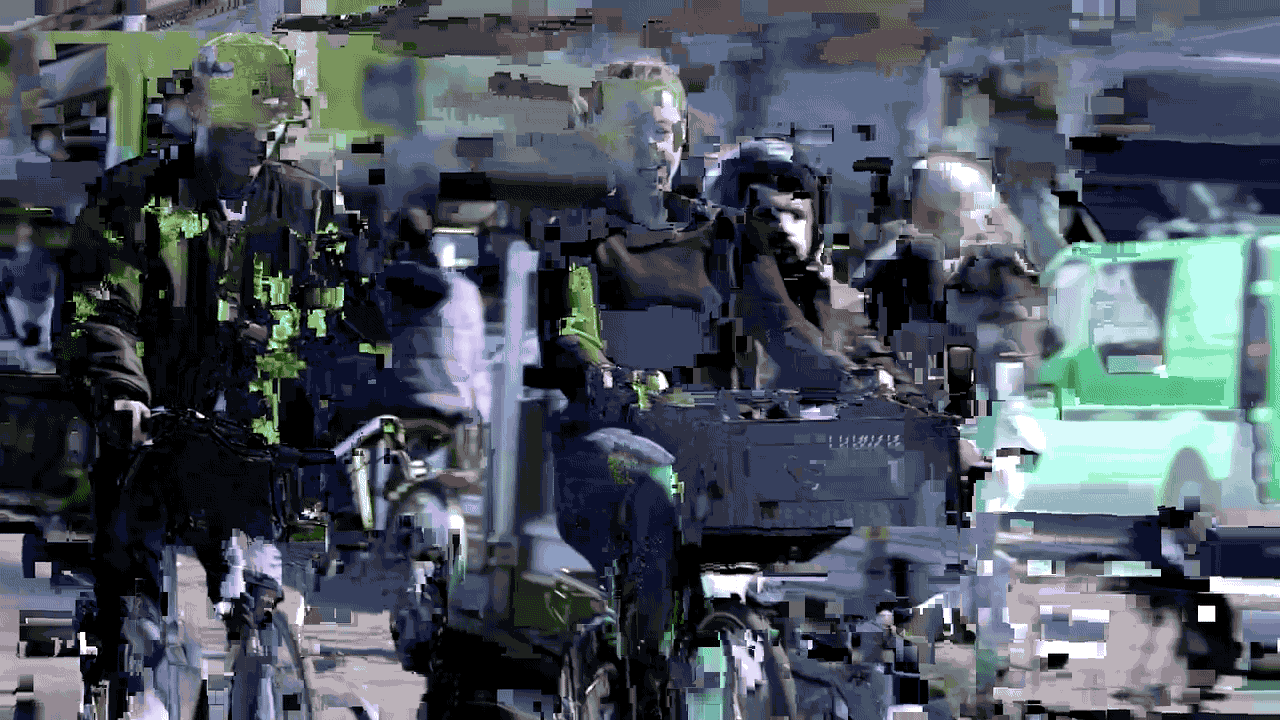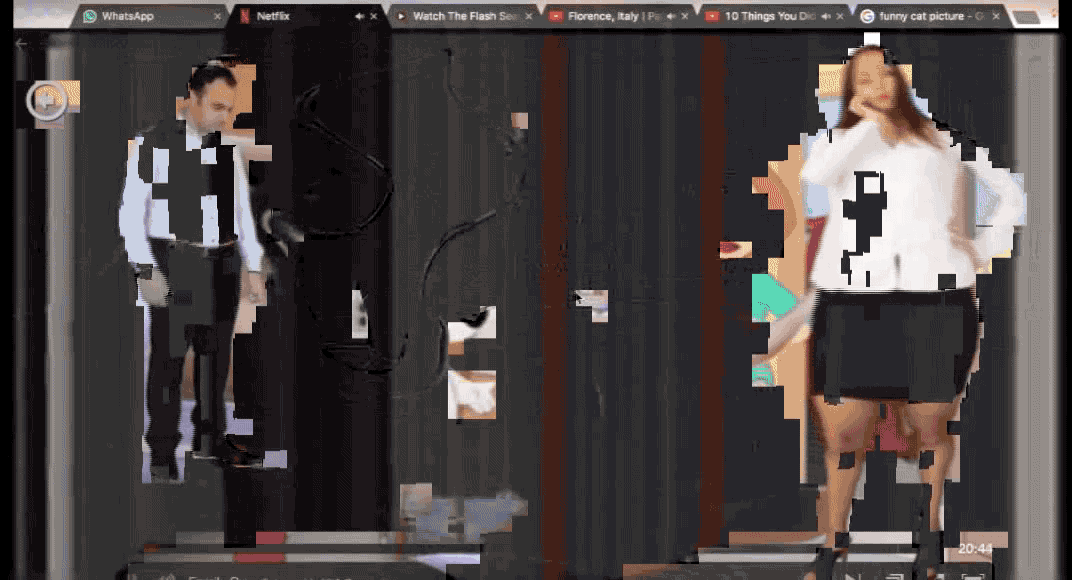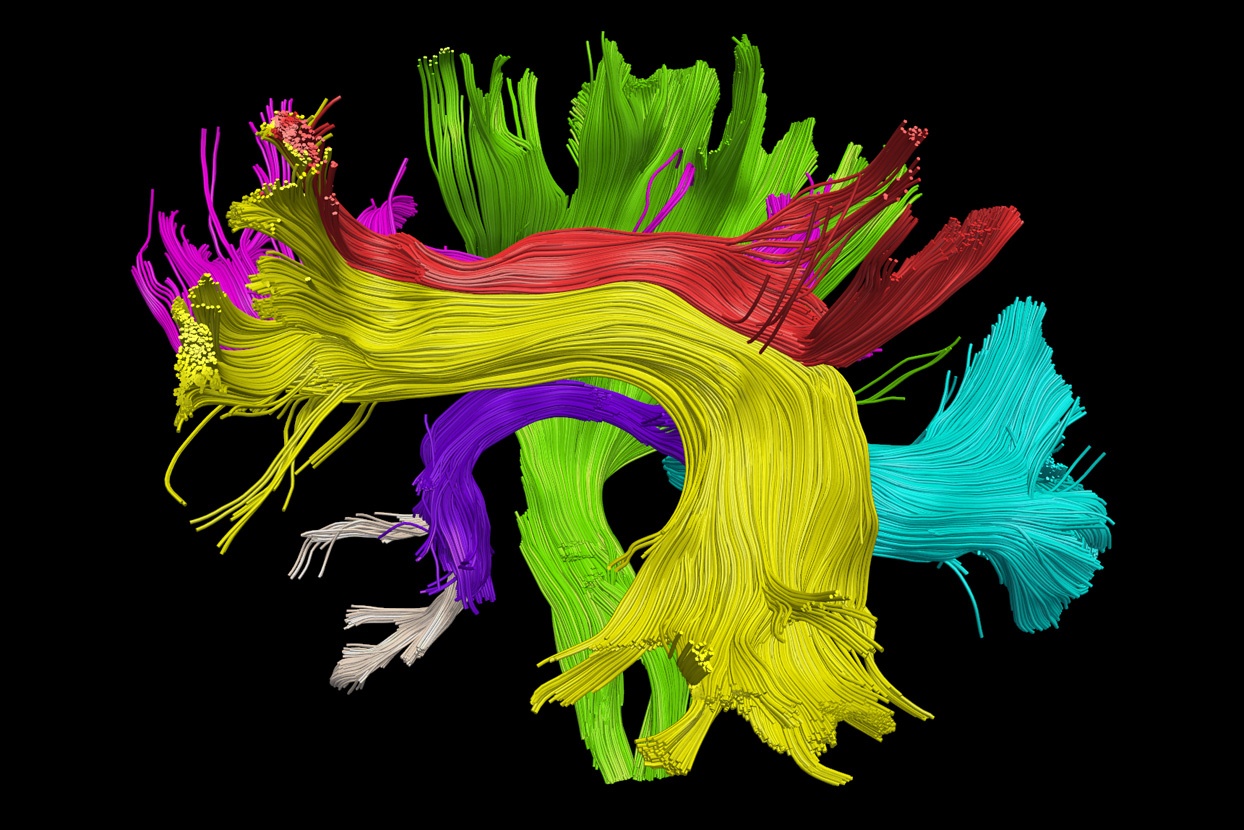Up, Sammy, Look Up
Intergenerational Knowledge and its Distractions
April 12, 2018essay,
How do we step away from a culture of docility, and move to a place of imperfect neuronal liberation, where amenity is no longer part of us? Malcolm Kratz argues that we should enrage ourselves against an economic, political and mediatic system that promotes flexibility and obedience, while accepting that our brain does not obey itself, that it overproduces and needs to get the pressure off. Kratz advocates education for a culture of neuroliberation. This essay is part of the DAI Open! Coop Academy research project (Against) Neuralgia: Care of the Brain in Times of Cognitive Capitalism.
Intergenerational Knowledge and its Distractions

Technology has enhanced our lives in countless ways. At the same time, it is the primary source of distraction that interferes with our pursuit of goals. Interference means hindering, obstructing or derailing other processes. The impacts of this can be found on many levels: thinking, perception, decision making, communication, emotional regulation and memory (in short executive functions) – our ability to learn and engage in social situations.1
But I’d like to say more about the process of interference before pointing all fingers at modern technology, or immersive media. Interference happens naturally: think of how the mind wanders, or surrounding sights, sounds and smells that distract you from focusing on the task at hand. These distractions are involuntary, but the interruptions are voluntary: for instance, thinking about a particular task or deliberately multitasking by working on another task or trying to focus on multiple sources of information (Facebooking during a lecture, listening to music while cleaning). The more complex a system gets, the more likely it falls prey to distraction – and the human mind is incredibly complex.
The dopaminergic system triggered by foraging for food is today triggered by foraging for information in a world of proliferating technologies and ways to access them amid ever-expanding information. Through this dopaminergic process, we give in only to short-term rewards, instead of potentially more rewarding long-term accomplishments. We are triggered by inner and outer interference, without the time to critically engage and contemplate in order to develop, what Bernard Stiegler, philosopher and head of the Institut de recherche et d'innovation, and N. Katherine Hayles, literary critic and previous director of the Electronic Literature Organisation, describe as (deep) attention. Continuous attention capture on the part of our digital devices leads us into a state of hyper attention, which excels in dealing with rapidly changing environments. When entered in its pure form, perception-action cycle (our animalistic action-reaction mechanism) overtakes cognitive control (our ability to pause and make conscious decisions). Yet hyper attention also makes it possible to switch between different input sources, making us alert to our environment and flexible within it, while vulnerable to outside and inside interruption as we skip over the reality principle: our executive functions. 2
Hyper attention today is not comparable to primitive modes of perception-action cycle, which embraced just the opposite, deep attention, attention trained on a specific object retained for extended periods of time. It facilitates problem-solving and is common in the field of the humanities, wherein it is still necessary to get the bottom of a specific topic even if it takes a lifetime. This attention is coincident with the luxury of modern day living, where there is seemingly no imminent danger lurking in the dark. When Maslov’s pyramid of needs is fulfilled, deeper contemplation can emerge, deep attention, that is, higher order processes of cognitive control and executive functions.3
Of course, in the predatory system of neoliberal capitalism, where scarcity is preferred over abundance and precariousness triumphs over the security we try to build, the pathways to deep attention is broken. Institutionalised education, however, remains based on the principles of deep attention. Long days seated, bent over books – exacerbated by schools shortening breaks and decreasing sports activities due to cuts – deep attention is so embedded in education that hyper attention isn’t event considered; it is a cognitive mode seen as a deficit.4 Yet we engage in distributing our attention when information becomes less predictable, our attention loses its precision and what we call hyper.5 Hyper attention is an updated pre-cognitive perception-action cycle, it is born out of unpredictability – the precariousness of society now.
Technology has changed how we do business, conduct our social lives, communicate and think.6 Our workplaces and the times we work are increasingly flexible. Instead of technology giving us more time, it blurs the boundary between work and free time. The portability of our devices doubles if not triples our working hours, deemed productive all day, every day. Hyper attention is a product of evolution, but it has metastisized in our contemporary times. When we foraged for food, all our basic needs were still uncertain; now foraging for information, our basic needs are there, but precarious, leading to a new form of instability.
The transfer of intergenerational knowledge (education) can adapt how it deals with attention, by focusing on everyday skills and a dynamic structure of action, reaction and contemplation (between hyper and deep attention). Particularly in times of boundless social media, news websites, blogs, flex work and ever-demanding healthy lifestyles, we need the dynamicity of hyper attention. Yet we are stuck in a vicious cycle: the young mind is captured by different media, leading to hyper attention through short information conditioning, after which the media cranks up the speed and impressiveness to push its message across (attract more attention), levelling the playing field once more so that greater stimuli are needed to capture the audience’s attention. Today’s society demands dynamic and flexible structures to stay alive. But in educational institutions, the advantages of hyper attention seem all but forgotten, given neurotypical labels like ADD or ADHD – also autism the label my therapist once gave me, could make the list.
Immersive media attracts attention, pulls focus towards it. Its flickering light (moving images) appeals to us, in the way a bonfire (nature’s television) can mesmerise the viewer. Attention is needed to make globally available feedback from our senses and thoughts conscious. Attention cannot be directed towards conscious thought or awareness of the body/surroundings when captured, possibly leading to problems with cognition and critical thought, for which one needs deep attention.
Conditioned Hyper and Deep Attention Through Neurocapture

Adults and minors are both reduced to the position of irresponsible consumers through this type of immersion. In times of social media, where tracking the past and present becomes literal capture of our identity online, we are grouped (although in a more complex/personalised way) into promotional categories for not only our consumption of particular goods but also into what I would call ‘lifestyle-subjectivities’: our political views, news articles, opinion pieces, [(pseudo)-scientific] facts, et cetera. We start to see everything we already like and news or ‘critical’ views we already agree with, ending up in echo chambers of our own (shaped) identity.7 A metaphor for this chamber can be found in the phenomenon of the neurodiverse ‘autistic’ trait: echopraxia. Someone mirrors or projects, unconsciously, the physical model of someone else. This mimicking of others is become conscious of only in copying, which makes the echopracter feel like others have more control over their body than themselves. The problem is many echo chamber dwellers, captured and distracted, are inert with respect to the control of the other. They haven’t become conscious, which needs attention, of the algorithm’s control over them.
Humans are at the edge of two evolutionary paths: competition over the unpredictable as we see in chimpanzees; and cooperation, the ability to simulate other beings and predict their future actions.8 Since their algorithms predict the future user behaviour, online platforms could be seen as cooperative. Yet they also reduce the possibility of unpredictability by filtering out information that most probably won’t be used, liked and shared by the targeted user, all designed to capture our attention and brain availability.9 Our synapses are strengthened – the connections between the neurones in our brain – to process short bursts of information while weakening those for retained attention leading to a collective Attention Deficit. Our brains compute for self-rewarding potential and predict rewarding events, directing us and our attention towards the most rewarding situation. In other words, our dopaminergic system gives constant input to the Phenomenal Self Model (PSM), labelling events more or less worthwhile. The PSM adapts itself to this new information and then starts to make better predictions for future rewarding events. It makes the events rewarding for the system itself, and bases its decisions on these reward-giving forecasts.10 We’re hooked.
Institutional Addiction

One suggestion would be to focus on cognitive function since it supports our resistance to distraction and allows us to critically reflect. Gazzaley and Rosen both support calculated, scientifically proven methods of cognitive brain training: cognitive brain games, meditation, drugs, video games, exercise, neurofeedback and nature.11
They write on current standardized practices of education, but seem to have forgotten to examine the relationship between institutional solutions of the past and current problems. The theories of Ivan Illich seem very relevant for today. He explains that institutionalized education confuses process and substance – that it turns teaching into the process of learning. Grades get mixed up with the word education, certificates and diplomas with competence, dismissing fluency as the ability to say something. Being schooled in an institution means accepting services instead of values, drawing erroneous analogies between medical treatment and health care, police and security, and urgency as productive work. Believing in self- healing through listening to one’s own body is irresponsible, and learning on one’s own and from life experience unreliable.12 School turns one of the automatic human abilities, learning, into a scientifically produced commodity. It disables the possibility to take control of our learning by discrediting it as a simplistic life experience. To learn means to acquire new skills or insights, while the school works mostly through promotion: praise and reward for following opinions formed by others, the school curriculum as social ranking system.
The school has monopolized the distribution of work and status, putting in jeopardy the opportunities of those who do not finish, leading to discrimination based on schooling,13 and enabling those who promote school liberty from social constructs.14 Teaching can of course, under certain circumstances, contribute to certain types of learning as planned learning and instruction can be very useful for the motivated available student. Students responsible for their own learning deal with the process of instructed learning way more ‘efficiently’. This means, however, that learning and teaching are also uncoupled from the licence to do so.15 Space for open-ended, exploratory use of acquired skills is something institutionalized education tries to control to measure the results of free acquisition of those skills. Since only skills that can be improved through drills, learning to master definable and predictable behaviour are supported, school education will never be capable of exploratory and creative use of skills, which are then standardized responses.16
The exchange of skills in a controlled environment seems less dangerous than the unlimited opportunity to meet among strangers and those who share socially, emotionally and intellectually important concerns, which is when learning happens quickest. Paulo Freire experienced this in instructing a group of illiterate activists who learned how to read within 48 hours. At the same time, it is obligatory that school separates away from the world those who spend more time in institutionalized academic and pedagogical learning environments.17
In the real world generations mix: the educational environment divides people according to age. Children ‘belong’ in schools, where they will learn or can be taught; education is related to the belief in childhood it produces. Childhood can be seen as a burden. It condemns those who are self-aware to the inhuman treatment of being ‘treated like a child’; without age-specific learning institutions there wouldn’t be an idea of childhood. Creating a world that is liveable for the young, liberated from segregated training camps of obedience that absorb all of one’s time and energy, there is space to do the learning that already happens outside of school:18 speaking, feeling, thinking, playing, cursing and politicking. This liberation has the potential to create a new space in which to join different minds, with the educated accustomed to their fellow educated citizens, happy in their company. Universities assess their students as potential money makers, promoting consumerist standards of produced knowledge, and transferring these ideals from the student onto the citizen. They manage critique through research and instruction, moving away from the physicality of lively debate found in the universities of the Middle Ages, and into the realm of mediatized print.19
Segregated obligatory education can never transgress the disadvantaging of the poor: the middle class has access to books and vacations; the poor do not.20 The media promotes thinking like the wealthy while living like poor. The school is touted as a place of salvation, but disables the ability to take control of one’s own learning, actively discouraging this. Children learn most from peer groups and chosen media like comic books and the Internet. School robs them of their ability to learn, taking away their self-respect, and imposes a system in which the need for education arises. The idea that we can only learn through a paid for institution, only consume the service of something we naturally inhibit, convinces us that all our activities take shape in institutionalized practice; valuable learning experience is exchanged with attendance. Learning increases with the amount of input; value itself can only be expressed in the form of measurement (grades and certifications). School, like media, conditions us in a machinic way. It manipulates us through responses, by knowing what to expect of others and destroying the unexpected. School, like media, packages value. It creates prefabricated measurable blocks of matter, limiting immeasurable personal growth, driving us to judge each other and ourselves based on the measurability of our capabilities. Everything is measurable; everything can be ranked, making everything expressible in a simple consumer’s index.
Education for a Culture of Neuroliberation

The school curriculum, as sold by the teacher to the student, is backed by science. Its outcomes are measured, produced and perfected through observation and feedback. It doesn’t matter if the institutional practice is designed by students, ungraded, team-based or issue-centred. The student is always left with a feeling of guilt for not matching the intended values of the class. It is those healthy students who feel manipulated and do not accept the judgement of others when learning must take place, who suffer. School leaves them, just like media, addicted – struck with the feeling that there is always more to learn, that the new generation of students are more up to date and the ones that drop out always regretting what they’ve missed. It preaches, just like the current economic system we live in, never-ending growth in education consumption. It leaves one with a feeling of never fully reaching maturity. School and the media both apply their institutionalized manipulation of our worldviews, languages and demands by forcing themselves into our lives. The media comes first, via entertainment, then as news and knowledge, to be followed by obligatory school, which becomes the living space of childhood, its footprint marking the synapses and neuronal structures of our brain.
Institutional practices of education are not a remedy to counteract hyper attention. Institutionalized practices of education feed into this loss of responsibility brought about by the media. To prevent the expansion of hyper attention and critical thinking we must go further than curricular change. Our brain is an example of historicity. Throughout our whole lives, it changes according to our interactions, through Long-Term Potentiation and Long-Term Depression (LTD). LTD involves the process of synaptic pruning I wrote on earlier,21 shaping our ‘selves’, our synaptic selves.22 Secondary neurogenesis allows for personal experiences to leave an imprint at the core of neuronal networks, making space for regular morphology and functional reworking. Metzinger argues that by not engaging in critical thought, you lose criticality.23 The disappearance of critical thought, or at least a reduction thereof, seems inevitable in times of continuous distraction: media and neurocapturing devices play into our perception action cycle; institutionalized education makes us passively obedient through active grading and discrediting of real-life learning experiences.
As Malabou asks: ‘What should we do with our brain?’ We should support each other, not just younger generations, to stop replicating ourselves in order to suit a caricature dictated by the world at large. We should use it to be critical of flexibility, since to be flexible means to take shape/receive form, while plasticity gives us the agency to give shape while also receiving it. We will hopefully learn to let go of our self-control and let our self-model come out – to ‘explode’ from rage. We might then relearn how to enrage ourselves through life experience, not simulation. How do we step away from a culture of docility, and move to a place of imperfect neuronal liberation, where amenity is no longer part of us? We should enrage ourselves against an economic, political and mediatic system that promotes flexibility and obedience, while accepting that our brain does not obey itself, that it overproduces and needs to get the pressure off. Our selves need to explode and give room to this frustration. Even though we try to keep hold of ourselves and control the outcome of our civilized personalities, our brains partly take shape unconsciously. As Malabou shows us: ‘[S]o long as we do not grasp political, economic, social, and cultural implications of the knowledge of cerebral plasticity available today, we cannot do anything with it.’24
1. Adam Gazzaley and Larry D. Rosen, The Distracted Mind: Ancient Brains in a High-Tech World (Cambridge, MA: MIT Press, 2016), 5.
2. See N. Katherine Hayles, 'Hyper and Deep Attention: The Generational Divide in Cognitive Modes', Profession 13 (2007); Thomas Metzinger, Being No One: The Self-Model Theory of Subjectivity (Cambridge, MA: MIT Press (2006); Gazzaley and Rosen, ibid.; and the work of Bernard Stiegler.
3. Hayles, Ibid., 188.
4. Ibid.
5. Gazzaley and Rosen, ibid., 71.
6. Hayles, ibid., 187.
7. Phil McRae, ’Forecasting the Future Over Three Horizons of Change’, ATA Magazine 90 (2009–2010), teachers.ab.ca.
8. Gazzaley and Rosen, ibid., 348.
9. See Catherine Malabou, What Should We Do with Our Brain? ed. J. Caputo and trans. S. Rand (New York: Fordham University Press, 2008).
10. Metzinger, ibid., 346.
11. Gazzaley and Rosen, ibid., 183–211.
12. Ivan Illich, Deschooling Society (Milan: KKIEN Publ. Int., 2013 [1971]), 3.
13. Ibid., 7.
14. Ibid., 21.
15. Ibid., 7.
16. Ibid., 9.
17. Ibid., 12.
18. Ibid., 14.
19. Ibid., 15.
20. Ibid., 5.
21. Malabou, ibid., 21.
22. Ibid., 57.
23. See Metzinger, ibid.
24. Malabou, ibid., 82.
Malcolm Kratz: My occupation is unknown. Not that it is a secret – it is merely because I don’t really know what I am. What I do know is that our society is fucked in the way it’s organized now. We’re hoping for some techno-fixes for our climate, while what we actually do is look away and carry on with our lives. Children are the new seeds of our society that should be supported in their free development of understanding, rationally and emotionally, but also in their movements and ways of thinking. We need to build a platform for cooperation, common the school system and think together with our kids about our future, the future of this planet and a post-growth society!
